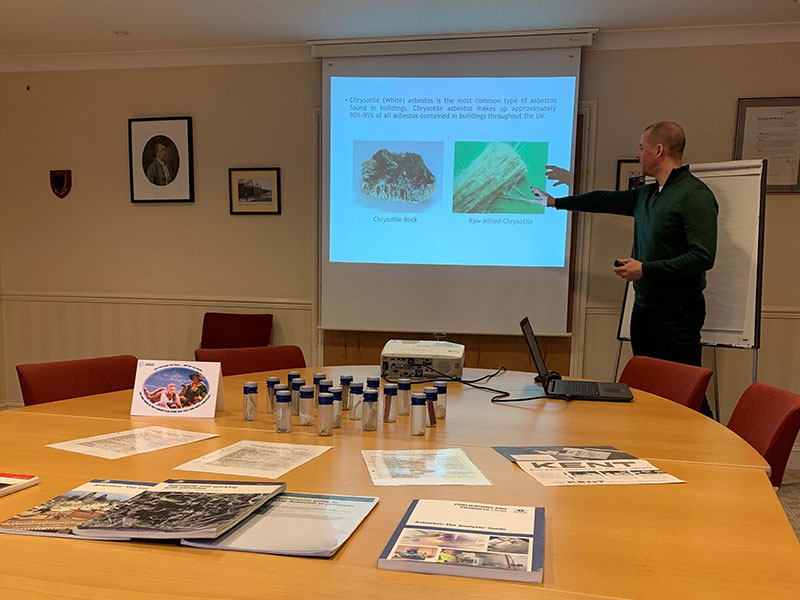What is the difference between Cat A and Cat B asbestos training?
While asbestos was fully banned in the UK in 1999, many older buildings still have asbestos-containing materials (ACMs). Working amongst asbestos can lead to serious health issues decades in the future. That’s why it’s so important to have the proper training if your job could expose you or others to airborne asbestos fibres.
Any employee who may work with or around ACMs should receive some sort of asbestos training. The level of training required depends on the type of work they perform.
All asbestos training programs cover the basics, but some go more in-depth than others. Detailed instruction is necessary for employees who require additional expertise in and prep for asbestos work.
In the UK, asbestos training falls into three main categories:
- Category A: Asbestos awareness
- Category B: Training for non-licensed work, including notifiable work
- Category C: Training for licensed work
In this article, we’ll take a deeper look at categories A and B to see how they differ and what’s required for each one.

What is Category A asbestos training?
Category (Cat) A asbestos training is also referred to as “Asbestos Awareness Training.” This is useful for any employee who could come in contact with an ACM.
The purpose of Cat A training is to clarify the risks associated with asbestos exposure. Furthermore, it explains how to avoid damaging ACMs to prevent exposure.
Asbestos materials are only dangerous if they’re damaged or disturbed. This is when toxic asbestos fibres are released into the air. When inhaled or swallowed, those fibres can adhere to the lungs. Respiratory diseases and certain types of cancer can result from asbestos exposure as far as 40 years in the future.
For this reason, all employees who work where ACMs are present should understand how to avoid damaging them and the serious implications that asbestos fibres have.
What’s included in Cat A asbestos training?
Asbestos Awareness Training includes information about the following topics:
- The general characteristics and properties of asbestos. This includes information about the most common types of ACMs and scenarios when asbestos becomes dangerous.
- Different types of asbestos found in buildings.
- Diseases that can result from asbestos and the effects of asbestos on the lungs.
- Best practices and control measures to limit exposure risk.
- Emergency procedures in case of an accidental exposure event.
Who should take Cat A asbestos training?
Any employer who works around asbestos but does not work directly with asbestos should take Cat A training. Examples of job roles include the following:
- Property managers
- Decorators
- Housekeeping
- Supervisors
People in these professions may work in the vicinity of ACMs but don’t have jobs that are likely to cause damage to the ACMs. That’s why the base level of asbestos training is all that’s required.
What is the structure of a Cat A training course?
Cat A training can be taken in person at a training centre or virtually through an online portal.
Online training is live, meaning you’ll be face-to-face with a trainer who’s conducting the course in real time. This allows for in-the-moment discussions and Q&A sessions.
The Cat A training course is 4 to 5 hours, and it’s considered a half-day course. The refresher course is shorter at around 2 hours.
Cat A training is good for 1 year (12 months). It should be refreshed at least every 12 months. For workers who show a need for a better grasp on the topic, refresher training can be taken more frequently.
What is Category B asbestos training?
Category (Cat) B asbestos training is also referred to as “Non-Licensed Asbestos Training.” This is useful for workers who need more information than what Cat A training provides.
The purpose of Cat B training is to explain asbestos safety measures so exposure risk is minimised. It’s intended for workers who have a high potential of disturbing ACMs or who come into direct contact with ACMs as part of their regular job.
What’s included in Cat B asbestos training?
Non-Licensed Asbestos Training includes information about the following topics:
- Asbestos safety procedures and control measures.
- How to conduct an asbestos risk assessment.
- Personal protective equipment to wear during asbestos work, including respiratory protective equipment.
- Emergency procedures in the event of asbestos exposure.
- What types of non-licensed work are notifiable, meaning they have additional requirements to meet.
Who should take Cat B asbestos training?
Anyone who comes into direct contact with ACMs while on the job should take Cat B training. Examples of impacted job roles include the following:
- Carpenters
- Construction workers
- Demolition workers
- HVAC engineers
- Plumbers
- Roofers
While not all direct asbestos work requires a license, there are still safety procedures to follow when performing non-licensed work.
Additionally, some of the job roles outlined in the Cat A asbestos training section may actually need Cat B training instead. For example, a painter who regularly paints asbestos insulation boards will need more advanced training than one who doesn’t. Since there’s a higher risk of asbestos exposure, more expertise is needed.
What is notifiable non-licensed asbestos work?
Notifiable non-licensed asbestos work is asbestos work that does not require a license but that does have additional requirements to meet beyond regular non-licensed work.
Conducting an asbestos risk assessment will determine whether or not the work is notifiable. In general, the riskier the work, the more likely it is that it’s notifiable. Considerations include:
- Asbestos Type: Some types of asbestos are more friable than others, meaning they’re more likely to crumble and release fibres. Additionally, some asbestos is well-bonded to the ACM, while other times, it’s not as well-bonded and therefore easier to damage.
- Condition of the ACM: If the material is in poor condition before work begins, it’s possible the work will be notifiable. This is because there’s a higher risk with already-damaged ACMs.
- Work Type: Certain types of asbestos work, like asbestos removal as part of a refurbishment, may be notifiable.
Whether or not work is notifiable is up to the discretion of the person in charge. However, if the work should be considered notifiable and you opt to not follow the necessary steps, you could have a compliance issue on your hands. Asbestos work that’s not handled properly can result in fines and even a prison sentence.
Cat B training provides guidance about what type of work is notifiable and the steps to take to stay compliant.
What is the structure of a Cat B training course?
The complete Cat B training course should be taken at an in-person training centre. However, refresher courses can be taken virtually online.
Like with online Cat A training, virtual Cat B training is conducted by a live trainer, allowing for real-time discussions and questions.
Cat B training is a full-day course and takes about 6 to 7 hours to complete. The refresher course is closer to the length of a half-day course at around 3 to 4 hours.
Also similarly, Cat B training is good for 1 year and should be refreshed at least annually. More frequent refresher courses should be taken based on the employee’s understanding of the topic.
In summary
By conducting a risk assessment, employers can determine what type of training is appropriate for their employees. It’s possible that some employees in a workplace will be fine with Cat A training, while others will need Cat B training to properly prepare them.
The main difference between Cat A and Cat B training is the depth of knowledge the attendee will get from the training. Cat A is best for those who only need the most basic asbestos information to detect ACMs and prevent exposure. Cat B training is necessary for anyone who will be working in close contact with ACMs, as they need more detailed instructions to carry out their job.
Both employers and employees should take asbestos training seriously. Having the proper amount of training is necessary for workplace safety and legal compliance.
For help assessing your training needs and taking action, contact our asbestos safety experts today.

Written by Brendan Coleman
Brendan Coleman, with decades of experience in the asbestos industry, is a dedicated Quality Manager. Certified as a surveyor and analyst, he is adept in operations and quality management with a keen focus on HSE compliance. His expertise is pivotal in maintaining high safety and efficiency standards. Brendan ensures our UKAS accreditation requirements are consistently met and exceeded, upholding stringent standards in asbestos remediation. His commitment to enhancing quality and customer satisfaction makes him an essential advisor in asbestos management.

